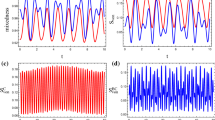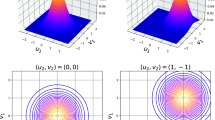Abstract
The dynamics of entanglement and uncertainty relation is explored by solving the time-dependent Schrödinger equation for coupled harmonic oscillator system analytically when the angular frequencies and coupling constant are arbitrarily time dependent. We derive the spectral and Schmidt decompositions for vacuum solution. Using the decompositions, we derive the analytical expressions for von Neumann and Rényi entropies. Making use of Wigner distribution function defined in phase space, we derive the time dependence of position–momentum uncertainty relations. To show the dynamics of entanglement and uncertainty relation graphically, we introduce two toy models and one realistic quenched model. While the dynamics can be conjectured by simple consideration in the toy models, the dynamics in the realistic quenched model is somewhat different from that in the toy models. In particular, the dynamics of entanglement exhibits similar pattern to dynamics of uncertainty parameter in the realistic quenched model.



Similar content being viewed by others
References
Schrödinger, E.: Die gegenwärtige Situation in der Quantenmechanik. Naturwissenschaften 23, 807 (1935)
Nielsen, M.A., Chuang, I.L.: Quantum Computation and Quantum Information. Cambridge University Press, Cambridge (2000)
Horodecki, R., Horodecki, P., Horodecki, M, Horodecki, K.: Quantum entanglement. Rev. Mod. Phys. 81, 865 (2009). arXiv:quant-ph/0702225
Einstein, A., Podolsky, B., Rosen, N.: Can quantum-mechanical description of physical reality be considered complete? Phys. Rev. A 47, 777 (1935)
Bennett, C.H., Brassard, G., Crepeau, C., Jozsa, R., Peres, A., Wootters, W.K.: Teleporting an unknown quantum state via dual classical and Einstein–Podolsky–Rosen channles. Phys. Rev. Lett. 70, 1895 (1993)
Bennett, C.H., Wiesner, S.J.: Communication via one- and two-particle operators on Einstein–Podolsky–Rosen states. Phys. Rev. Lett. 69, 2881 (1992)
Scarani, V., Lblisdir, S., Gisin, N., Acin, A.: Quantum cloning. Rev. Mod. Phys. 77, 1225 (2005). arXiv:quant-ph/0511088
Ekert, A.K.: Quantum cryptography based on bells theorem. Phys. Rev. Lett. 67, 661 (1991)
Kollmitzer, C., Pivk, M.: Applied Quantum Cryptography. Springer, Heidelberg (2010)
Ladd, T.D., Jelezko, F., Laflamme, R., Nakamura, Y., Monroe, C., O’Brien, J.L.: Quantum computers. Nature 464, 45 (2010). arXiv:1009.2267 (quant-ph)
Vidal, G.: Efficient classical simulation of slightly entangled quantum computations. Phys. Rev. Lett. 91, 147902 (2003). arXiv:quant-ph/0301063
Ghernaouti-Helie, S., Tashi, I., Laenger, T., Monyk, C.: SECOQC business white paper. arXiv:0904.4073 (quant-ph)
Hill, S., Wootters, W. K.: Entanglement of a pair of quantum bits. Phys. Rev. Lett. 78, 5022 (1997) arXiv:quant-ph/9703041
Wootters, W. K.: Entanglement of formation of an arbitrary state of two qubits, ibid. 80, 2245 (1998) arXiv:quant-ph/9709029
Horodecki, R., Horodecki, M.: Information-theoretic aspects of inseparability of mixed states. Phys. Rev. A 54, 1838 (1996). arXiv:quant-ph/9607007
Bekenstein, J.D.: Black holes and entropy. Phys. Rev. D 7, 2333 (1973)
Hawking, S.W.: Breakdown of predictability in gravitational collapse. Phys. Rev. D 14, 2460 (1976)
’t Hooft, G.: On the quantum structure of a black hole. Nucl. Phys B 256, 727 (1985)
Bombelli, L., Koul, R.K., Lee, J., Sorkin, R.D.: Quantum source of entropy for black holes. Phys. Rev. D 34, 373 (1986)
Srednicki, M.: Entropy and area. Phys. Rev. Lett. 71, 666 (1993)
Solodukhin, S.N.: Entanglement entropy of black holes. Living Rev. Relativ. 14, 8 (2011). arXiv:1104.3712 (hep-th)
Eisert, J., Cramer, M., Plenio, M.B.: Area laws for the entanglement entropy–a review. Rev. Mod. Phys. 82, 277 (2010). arXiv:0808.3773 (quant-ph)
Vidal, G., Latorre, J.I., Rico, E., Kitaev, A.: Entanglement in quantum critical phenomena. Phys. Rev. Lett. 90, 227902 (2003). arXiv:quant-ph/0211074
Levin, M., Wen, X.-G.: Detecting topological order in a ground state wave function. Phys. Rev. Lett. 96, 110405 (2006). arXiv:cond-mat/0510613
Jiang, H.-C., Wang, Z., Balents, L.: Identifying topological order by entanglement entropy. Nat. Phys. 8, 902 (2012). arXiv:1205.4289 (cond-mat)
Cohen-Tannoudji, C., Diu, B., Laloë, F.: Quantum Mechanics. Wiley, Toronto (1977)
Han, D., Kim, Y. S., Noz, M. E.: Coupled harmonic oscillators and Feynman’s rest of the universe. arXiv:cond-mat/9705029
Feymann, R.P.: Statistical Mechanics. Benjamin/Cummings, Reading, MA (1972)
Makarov, D.N.: Coupled harmonic oscillators and their quantum entanglement. arXiv:1710.01158 (quant-ph)
Ghosh, S., Gupta, K.S., Srivastava, S.C.L.: Entanglement dynamics following a sudden quench: an exact solution. arXiv:1709.02202 (quant-ph)
Ikeda, S., Fillaux, F.: Incoherent elastic-neutron-scattering study of the vibrational dynamics and spin-related symmetry of protons in the \(KHCO_3\) crystal. Phys. Rev. B 59, 4134 (1999)
Fillaux, F.: Quantum entanglement and nonlocal proton transfer dynamics in dimers of formic acid and analogues. Chem. Phys. Lett. 408, 302 (2005)
Romero, E., Augulis, R., Novoderezhkin, V.I., Ferretti, M., Thieme, J., Zigmantas, D., van Grondelle, R.: Quantum coherence in photosynthesis for efficient solar-energy conversion. Nat. Phys. 10, 676 (2014)
Halpin, A., Johnson, P.J.M., Tempelaar, R., Murphy, R.S., Knoester, J., Jansen, T.L.C., Miller, R.J.D.: Two-dimensional spectroscopy of a molecular dimer unveils the effects of vibronic coupling on exciton coherences. Nat. Chem. 6, 196 (2014)
Lewis Jr., H.R., Riesenfeld, W.B.: An exact quantum theory of the timedependent harmonic oscillator and of a charged particle in a timedependent electromagnetic field. J. Math. Phys. 10, 1458 (1969)
Lohe, M.A.: Exact time dependence of solutions to the time-dependent Schrödinger equation. J. Phys. A: Math. Theor. 42, 035307 (2009)
Pinney, E.: The nonlinear differential equation. Proc. Am. Math. Soc. 1, 681 (1950)
Grobe, R., Rzazewski, K., Eberly, J.H.: Measure of electron-electron correlation in atomic physics. J. Phys. B 27, L503 (1994)
Ekert, A., Knight, P.L.: Entangled quantum systems and the Schmidt decomposition. Am. J. Phys. 63, 415 (1995)
Kim, Y.S., Noz, M.E.: Phase Space Picture of Quantum Mechanics. World Scientific, Singapore (1991)
Coffman, V., Kundu, J., Wootters, W.K.: Distributed entanglement. Phys. Rev. A 61, 052306 (2000). arXiv:quant-ph/9907047
Ou, Y.U., Fan, H.: Monogamy inequality in terms of negativity for three-qubit states. Phys. Rev. A 75, 062308 (2007). arXiv:quant-ph/0702127
Acknowledgements
This work was supported by the Kyungnam University Foundation Grant, 2016.
Author information
Authors and Affiliations
Corresponding author
Appendix A
Appendix A
In this appendix we examine how to extend the main results of this paper to the excite states. If, for example, two oscillators are in ground and first-excited states initially, the reduced density matrix becomes
where \( \rho _{(0, 0)}^A (x_1, x'_1: t)\) is given in Eq. (4.2) and
The explicit expression of \(a_3\) is given in Eq. (4.3). Then one can show
where r(t) is ratio of mixedness between \(\rho _{(0,0)}^A\) and \(\rho _{(0,1)}^A\) and its explicit expression is
We expect that the entanglement between ground and first-excited harmonic oscillators is very small compared to that between two ground state harmonic oscillators. However, it is difficult to show this explicitly because the analytic derivation of eigenvalues and eigenfunctions for \( \rho _{(0,1)}^A (x, x': t)\) does not seem to be simple matter, at least for us. We hope to discuss the dynamics of entanglement for general excited (m, n) state in the future. The time dependence of the uncertainty \(\Delta x_1 \Delta p_1\) for \(\rho _{(0,1)}^A\) can be computed analytically. The Wigner function \(W_{(0,1)} (x_1, p_1, t)\) for this state becomes
where \(W_{(0,0)} (x_1, p_1, t)\) is the Wigner function for \(\psi _{0,0} (x_1, x_2, t)\) given in Eq. (5.5) and
Then, it is straightforward to show that the uncertainty relation for \(\rho _{(0,1)}^A\) becomes \((\Delta x_1 \Delta p_1)^2 = \Gamma (t) / 4\), where
where \(\alpha _j\) are defined in Eq. (5.6).
(Color online) The time dependence of ratio for mixedness r(t) (a) and uncertainties \(\Gamma (t) / \Omega (t)\) (b) between \(\rho _{(0,0)}^A\) and \(\rho _{(0,1)}^A\) in the realistic quenched model. We choose \(\omega _{1, i} = 1\), \(\omega _{1, f} = 1.3\), \(\omega _{2, i} = 1.5\), and \(\omega _{2, f} = 1.8\) for \(J = 1.1\) (red solid line), \(J = 0.9\) (blue dashed line), and \(J = 0.6\) (black dotted line). Since \(r(t) < 1\) in the full range of time. a Indicates that \(\rho _{(0,1)}^A\) is more mixed state than \(\rho _{(0,0)}^A\). It is of interest to note that \(\rho _{(0,1)}^A\) becomes more and more mixed compared to \(\rho _{(0,0)}^A\) with increasing the coupling constant J. b Shows that the uncertainty \(\Delta x_1 \Delta p_1\) increases in \(\rho _{(0,1)}^A\) compared to that of \(\rho _{(0,0)}^A\). The increasing rate becomes larger with increasing the coupling constant J
The time dependence of the ratios r(t) and \(\Gamma (t) / \Omega (t)\) for the realistic quenched model is plotted in Fig. 4, where \(\omega _{1, i} = 1\), \(\omega _{1, f} = 1.3\), \(\omega _{2, i} = 1.5\), and \(\omega _{2, f} = 1.8\) are chosen. The red solid, blue dashed, and black dotted lines correspond to \(J=1.1\), \(J=0.9\), and \(J=0.6\), respectively. The fact \(r(t) < 1\) in the full range of time indicates that \(\rho _{(0,1)}^A\) is more mixed than \(\rho _{(0,0)}^A\). It is of interest to note that \(\rho _{(0,1)}^A\) becomes more mixed compared to \(\rho _{(0,0)}^A\) with increasing the coupling constant J. Figure 4b indicates that the uncertainty \(\Delta x_1 \Delta p_1\) increases in \(\rho _{(0,1)}^A\) compared to that of \(\rho _{(0,0)}^A\). The increasing rate becomes larger with increasing the coupling constant J.
Rights and permissions
About this article
Cite this article
Park, D. Dynamics of entanglement and uncertainty relation in coupled harmonic oscillator system: exact results. Quantum Inf Process 17, 147 (2018). https://doi.org/10.1007/s11128-018-1914-x
Received:
Accepted:
Published:
DOI: https://doi.org/10.1007/s11128-018-1914-x





